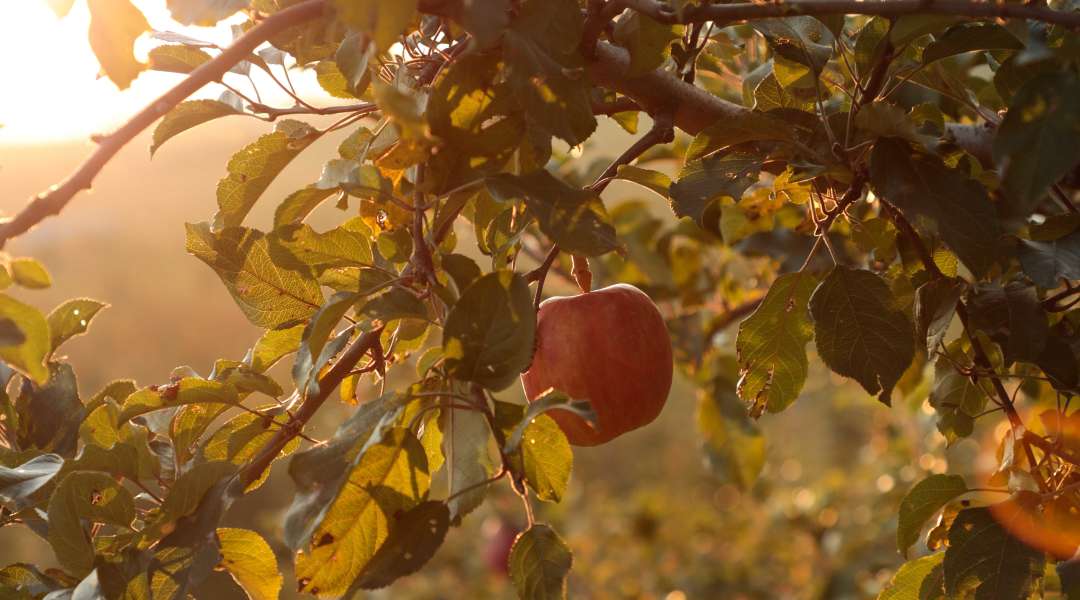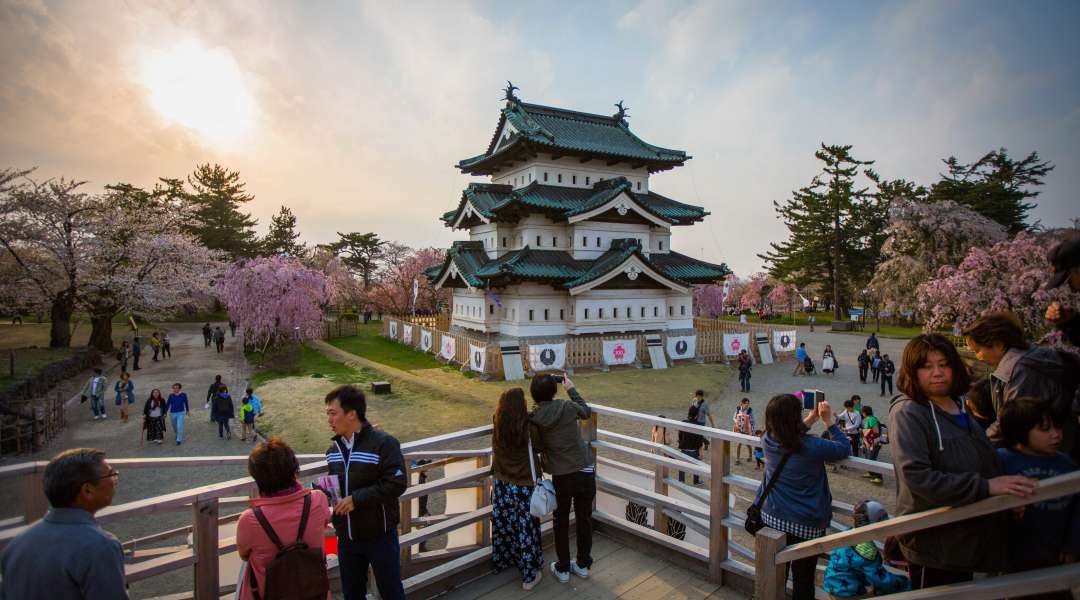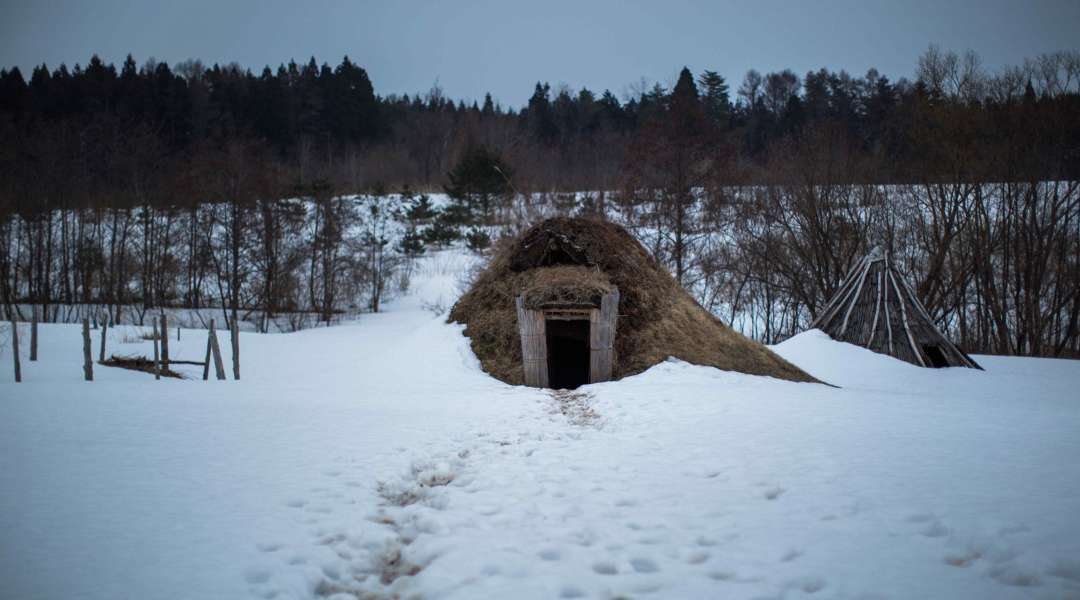 An apple artist arranging Hirosaki's famous green and red apples into a collage of a samurai © Aomori prefecture
An apple artist arranging Hirosaki's famous green and red apples into a collage of a samurai © Aomori prefecture
Ask any Japanese person, and they’ll tell you that Aomori, on the northernmost tip of Japan’s main island of Honshu, is most famous as Japan’s ‘apple prefecture’, but there is so much more than apples to Aomori…
As the orchard of Japan, Aomori offers abundant opportunities for apple-picking and cider-quaffing - but it is also host to plenty of other activities to keep you amused and entertained all year round. The prefecture is home to one of the country’s top spring cherry blossom viewing spots at Hirosaki Castle as well as one of its most impressive summer festivals in the form of the breath-taking Aomori Nebuta Matsuri.
There are also plentiful opportunities for enjoying modern art, ancient history, and lively local dining, as well as couple of Aomori one-of-a-kind experiences in the shape of Hakkoda’s lurking ‘snow monsters’ and Inakadate’s unique rice paddyfield art. Don’t miss our top ‘picks’ if you venture to Aomori!
1. Go Apple-picking for ‘Aomori Ringo’
 A juicy red apple at Golden Hour in Hirosaki Apple Park © Aomori prefecture
A juicy red apple at Golden Hour in Hirosaki Apple Park © Aomori prefecture
The first thing most Japanese people think of when they hear the word ‘Aomori’ is ‘apples’. In fact, the prefecture is Japan’s leading producer of apples, which were first cultivated in Japan in the Meiji Period (1868-1912). During the apple harvesting season from early August to mid November, apple-picking is a popular activity for visitors to Aomori. There are farms dotted all over the prefecture where you can eat freshly picked apples on the spot, or pick them to take home for eating later.
Try your hand at picking Aomori’s most famous export at Hirosaki Apple Park, home to over 1,300 apple trees of 65 different varieties. Visitors can experience what it’s like to be an apple-picker, sorting and bagging the apples, pruning the leaves, and exploring the orchard. The Ringo no Ie (Apple House) shop stocks over 1,250 apple-related products, from sweets to handicrafts, while the cafe serves up apple-inspired dishes such as apple curry and apple ice cream. There’s also an old farmhouse, a play area and a picnic area for the kids.
For the adults (Japan's legal drinking age is 20 years old), another option is to drop in at Hirosaki Cidre Factory Kimori, a cider factory established by local apple farmers where you can taste a rarity in Japan - carbonated alcoholic cider (as many a disappointed cider fan has discovered on arrival in Japan, in Japanese the word ‘cider’ is used to refer to a type of traditional lemonade). The city of Hirosaki is particularly closely associated apples, which leads us on nicely to our next recommendation...
2. Stroll in Hirosaki Castle and Park
 Hirosaki Castle ground in springtime © Aomori prefecture
Hirosaki Castle ground in springtime © Aomori prefecture
There are over 100 castles in Japan, but Hirosaki Castle should be firmly on your list of those to visit. Why? Its castle keep is one of the few in Japan - and the only one in the Tohoku region - that is not a modern reconstruction. The castle was originally built in 1611 by the Tsugaru clan; the current keep was rebuilt in the Edo period in 1811 and survives intact along with several castle gates, corner turrets (yagura), and fortified moats.
There is one more reason why you should visit Hirosaki Castle. Together, the castle grounds and surrounding
Hirosaki Park are one of Japan’s most famous cherry blossom viewing spots. The reason? Local apple farmers have applied the same vigorous pruning techniques to the cherry trees, encouraging larger, thicker clusters of buds that maximize the beauty of the blossoms.
Over a million people each year enjoy the park’s 2,600 cherry trees - more than 300 of which are over a century old - during the annual cherry blossom festival from late April until early May. With petal-filled moats, cherry blossom tunnels, night-time illuminations, rental rowing boats and picnic areas, Hirosaki Castle offers multiple cherry blossom activities all in one place. The castle and park are open 9:00-17:00 (later during cherry blossom festival) from April to late November and cost either 310 yen (£2.10, castle only) or 510 yen (£3.45, castle, botanical garden).
If you can tear yourself away from the blossoms for long enough, there is plenty else to do in the vicinity - try Hirosaki Castle Botanical Garden in the park’s southeast, Gokoku Shrine in the northwest, and Hirosaki’s well-preserved district of former samurai residences to the north of the park.
3. Party at the Aomori Nebuta Festival
 A decorated lantern float on parade at Hirosaki Neputa Matsuri festival © Aomori prefecture
A decorated lantern float on parade at Hirosaki Neputa Matsuri festival © Aomori prefecture
Other than apples, Aomori is best known for the Aomori Nebuta Festival, held in Aomori city each year at the beginning of July. Although no one quite knows how it began, one thing is for sure - it's one of Japan's hottest festivals right now! One of the three largest festivals in the Tohoku region, each year over three million visitors arrive in Aomori to join in the several days of festivities.
The event sees twenty dynamic “nebuta” - enormous lantern floats based on myths or kabuki stories - parade through Aomori city, accompanied by colourfully dressed “haneto” (dancers), flautists and taiko drummers. The sight of the brightly coloured, several metre tall floats decorated with fearsome samurai, gods, monsters and animals parading down the street at night is quite simply breathtaking.
In the daytime, many of the floats are exhibited at ‘stables’ where you can get a closer look and chat to the makers. Even the local ocean life gets a chance to get in on the action, as on the final night the floats are loaded onto boats and ferried around Aomori Bay as a blazing fireworks show lights up the night sky - a truly once-in-a-lifetime experience.
If you’re planning to attend, arrive early to bag a prime spot among the free seating along the parade’s 3km long route, or splash out for reserved seats, which can be purchased from convenience stores. But why stay on the sidelines when you can get into the thick of the action? Anyone is welcome to join in the float parade, providing they are wearing the correct uniform, the traditional haneto costume. Buy it at shops throughout Aomori for around 7000 yen / £47 or rent it for the day 3000 yen / £20. Learn more about Aomori Nebuta festival
here.
Bonus - Nebuta Warasse Museum
If you’re not in town on the dates of the festival, don’t worry - you can still sample the spirit of the festival at
Nebuta Warasse, a museum dedicated to the Nebuta Festival. The museum attempts to give visitors a taste of the festival’s lively atmosphere, history and traditions, with displays of images, objects and sounds from its 300-year history, live haneto performances, and five actual floats on display. The Warasse is open from 9:00-19:00 (until 18:00 September-April) and costs 600 yen / £4.
4. Go Back in Time at Sannai Maruyama Archaeological Site
 Footsteps in the snow lead toward a historic Jomon-style thatched hut © Aomori prefecture
Footsteps in the snow lead toward a historic Jomon-style thatched hut © Aomori prefecture
Together with similar sites in Hokkaido, Akita and Iwate, this unique archaeological site from Japan’s prehistoric Jomon period (14,000-300 BC) is currently under consideration to become a UNESCO World Heritage site, so get in ahead of the curve (and the crowds!) and visit it while it’s still relatively unknown. The site is just around the corner from Aomori Art Museum, so combining the two destinations makes for a no-fuss day out.
Discovered by accident during surveying to build a baseball field for the local community, the Maruyama site is not only the largest but also one of the most complete and best preserved Jomon period villages in Japan. Excavations found that the village once included a whopping 700 structures, including dwellings, roads, storage buildings, middens and burial pits - so more of a prehistoric town than a ‘village’, really! After being fully excavated and studied, it was reburied except for a few excavation sites which visitors can see, and a cluster of pit dwellings, longhouses and a large watchtower was constructed to give an idea of what the village once looked like, long, long ago.
Meanwhile, the various artefacts discovered during the dig are now displayed in the Jomon Jiyukan building, where you can learn about the people who inhabited the village/town during its heyday, try on Jomon period costumes, and try using Jomon period tools or making traditional toys and handicrafts. The Maruyama site is open 9:00-17:00 (until 18:00 June-September) and is totally free to enter.
5. Meet ‘Aomori-ken’ at Aomori Museum of Art
 The entrance to Aomori Museum of Art illuminated by artful neon tree designs © Aomori prefecture
The entrance to Aomori Museum of Art illuminated by artful neon tree designs © Aomori prefecture
From prehistory to modernity... Take a short stroll around the corner to your next destination: Aomori Museum of Art. The museum - which came later, obviously! - was designed to echo the Jomon period site next door. The large, minimalist display spaces for the artworks (including that of Aomori-ken, who we’ll get onto in a moment!) are dug down into the earth like excavation trenches, and the buildings are painted white to resemble the white tents of an archaeological dig.
Despite the ancient inspiration of the art museum’s buildings, the art in question is unashamedly modern. Follow the signs up and down some stairs and around the building to find Aomori-ken, Nara Yoshitomo’s famous giant 8.5 metre tall white dog statue, and spend some time in search of the perfect angle for a selfie with Aomori's most famous canine resident. However, getting nose to nose with Aomori-ken (‘ken’ is a suffix meaning ‘dog’ in Japanese) is just one of several highlights awaiting you at Aomori’s premier art destination.
Other must-sees include a collection of popular Japanese artist Nara Yoshitomo’s approachable cartoonish artworks; paintings and woodblock prints by Munakata Shiko; and three huge paintings by Marc Chagall that were originally the backdrops for a ballet - to give you some idea of the size, they’re hung in a room with 19 metre ceilings that is sometimes also used as a concert hall venue! The museum is open 9:00-17:00 (until 18:00 June-September) and costs 510 yen / £3.45 (permanent exhibit; prices for temporary exhibits vary).
6. Dine Out at Miroku Alley
 A man walks down Miroku Allet in Hachinohe's Yatai Mura street food village © Aomori prefecture
A man walks down Miroku Allet in Hachinohe's Yatai Mura street food village © Aomori prefecture
Chow down on local food while chatting up the locals at Hachinohe Yatai Mura (Hachinohe Food Stall Village) in the city of Hachinohe. Also known by its nickname of Miroku Yokocho (Miroku Alley), this narrow street is filled with food stalls, each of which seats only around eight diners, all competing to offer you the best of Hachinohe’s local cuisine. Dine on a cornucopia of local delicacies, from seafood freshly caught at Hachinohe port and turned into sushi, sashimi and grilled fish to local staples such as Hachinohe ramen and Senbei-jiru (a traditional hot-pot with the unusual addition of crackers) - all washed down with copious amounts of local Aomori sake.
However, the real attraction and novelty of Miroku Yokocho is that, until the winter chill sets in, the densely packed stalls all remove their partition walls and sliding doors, turning the whole alley into one giant outdoor street food party. The lack of walls and doors removes any physical barriers to communication, enabling diners - locals and tourists alike - to turn around and make friends with their neighbours. Even if they’re actually eating across the street at another establishment, they’ll be within easy waving and talking distance.
While settling in for duration of the evening at one stall is certainly one way to sample Miroku Yokocho’s open and convivial atmosphere, stall-hopping is a great way to meet and talk to as many people as possible, at the same time as giving you the opportunity to sample more of the diverse cooking styles of the alley’s 26 permanent food stalls - a true ‘two birds with one stone’ approach!
7. Meet Mt Hakkoda’s Snow Monsters
 Mt Hakkoda's snow laden fir trees, or 'snow monsters', with surrounding mountains in the background © Aomori prefecture
Mt Hakkoda's snow laden fir trees, or 'snow monsters', with surrounding mountains in the background © Aomori prefecture
Mt Hakkoda’s deep snowfall has earned it a reputation as one of the last undiscovered skiing destinations in Japan. Covering most of the mountain’s northern face, Hakkoda Ski Resort is famed for its deep powder and ungroomed off-piste trails, which are eagerly sought after by hardcore powder hounds from around the globe. But it’s not just the powder on the ground that entices tourists to venture out to Mt Hakkoda in the freezing depths of winter…
Every year, an icy army of Game of Thrones-style proportions marches on the area, as Hakkoda’s famous ‘snow monsters’ - ice-covered trees to you and me - take up residence for the duration of the winter. The ‘monsters’ form when cold water droplets carried on strong seasonal winds clash into the branches of evergreen trees, freezing in place to create unique and terrifying shapes. Together with Zao Onsen in Yamagata prefecture, Hakkoda is one of only two areas in Japan with the right winter conditions to develop the ‘snow monsters’, known by the slightly less poetic name ‘juhyo’ (ice trees) in Japanese.
If you’re feeling particularly adventurous, wrap up warm and venture out to join a snowshoe tour in subzero temperatures, dodging the eerily misshapen forms of the ‘snow monsters’ as they lurk and loom out at you from the snow and mist-filled air. Or see them the easy way by hopping on the
Hakkoda Ropeway for the 10-minute ride up to the top of the mountain (adult return ticket 1,850 yen / £12.50).
8. Marvel at Inakadate's Rice Paddyfield Art
 Mythological Japanese scenes depicted in rice paddy art © Aomori prefecture
Mythological Japanese scenes depicted in rice paddy art © Aomori prefecture
From the snowy slopes of Mt Hakkoda to the verdant rice paddyfields of Inakadate village - and the incredible giant artworks that adorn them. Searching for an authentic and unusual way to help revitalize their town, the inhabitants of Inakadate village began creating ‘tanbo art’ or rice paddyfield art in 1993, after discovering that rice had been cultivated in the local area for over 2,000 years.
Different types of rice are used to create the gigantic pictures in hues of vibrant green, burnished brown and dusty yellow. Past designs have drawn inspiration from a variety of sources from classical art to pop culture, including the Mona Lisa, Hokusai’s The Great Wave, and even Godzilla and Star Wars! The images are cleverly designed using perspective drawing methods so that they look their best when viewed from the nearby purpose-built observation platform - clambering up here is your best bet to capture those Instagram-worthy shots.
Every year, over 100,00 visitors from far and wide travel to see Inakadate’s rice art, so follow in the footsteps of the Emperor and Empress of Japan, who popped in for a quick look in 2014. Or, go one step further and don’t just look at the rice art - help to create it! Visitors can join rice planting tours at the beginning of June, and rice harvesting tours at the end of September. Both tours include a free lunch or hearty snack of onigiri (rice ball) and tonjiru (pork miso soup), as well as the precious opportunity to mingle with the locals.
 An apple artist arranging Hirosaki's famous green and red apples into a collage of a samurai © Aomori prefecture
An apple artist arranging Hirosaki's famous green and red apples into a collage of a samurai © Aomori prefecture
 A juicy red apple at Golden Hour in Hirosaki Apple Park © Aomori prefecture
A juicy red apple at Golden Hour in Hirosaki Apple Park © Aomori prefecture
 Hirosaki Castle ground in springtime © Aomori prefecture
Hirosaki Castle ground in springtime © Aomori prefecture
 A decorated lantern float on parade at Hirosaki Neputa Matsuri festival © Aomori prefecture
A decorated lantern float on parade at Hirosaki Neputa Matsuri festival © Aomori prefecture
 Footsteps in the snow lead toward a historic Jomon-style thatched hut © Aomori prefecture
Footsteps in the snow lead toward a historic Jomon-style thatched hut © Aomori prefecture
 The entrance to Aomori Museum of Art illuminated by artful neon tree designs © Aomori prefecture
The entrance to Aomori Museum of Art illuminated by artful neon tree designs © Aomori prefecture
 A man walks down Miroku Allet in Hachinohe's Yatai Mura street food village © Aomori prefecture
A man walks down Miroku Allet in Hachinohe's Yatai Mura street food village © Aomori prefecture
 Mt Hakkoda's snow laden fir trees, or 'snow monsters', with surrounding mountains in the background © Aomori prefecture
Mt Hakkoda's snow laden fir trees, or 'snow monsters', with surrounding mountains in the background © Aomori prefecture
 Mythological Japanese scenes depicted in rice paddy art © Aomori prefecture
Mythological Japanese scenes depicted in rice paddy art © Aomori prefecture

















































